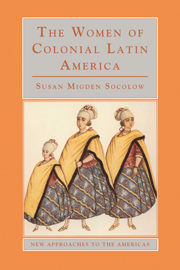Book contents
- Frontmatter
- Contents
- List of Illustrations
- Acknowledgments
- Introduction: Why Women?
- 1 Iberian Women in the Old World and the New
- 2 Before Columbus: Women in Indigenous America and Africa
- 3 Conquest and Colonization
- 4 The Arrival of Iberian Women
- 5 Women, Marriage, and Family
- 6 Elite Women
- 7 The Brides of Christ and Other Religious Women
- 8 Women and Work
- 9 Women and Slavery
- 10 Women and Social Deviance: Crime, Witchcraft, and Rebellion
- 11 Women and Enlightenment Reform
- Conclusion
- Documents
- Suggested Further Reading
- Index
- Plate section
9 - Women and Slavery
Published online by Cambridge University Press: 05 June 2012
- Frontmatter
- Contents
- List of Illustrations
- Acknowledgments
- Introduction: Why Women?
- 1 Iberian Women in the Old World and the New
- 2 Before Columbus: Women in Indigenous America and Africa
- 3 Conquest and Colonization
- 4 The Arrival of Iberian Women
- 5 Women, Marriage, and Family
- 6 Elite Women
- 7 The Brides of Christ and Other Religious Women
- 8 Women and Work
- 9 Women and Slavery
- 10 Women and Social Deviance: Crime, Witchcraft, and Rebellion
- 11 Women and Enlightenment Reform
- Conclusion
- Documents
- Suggested Further Reading
- Index
- Plate section
Summary
I declare that when I married doña Margarita Mexia, she brought with her as her dowry 1,000 pesos and a black slave named Catalina de la Cruz, and that the said slave has produced seven other slaves [piezas de esclavos y esclavas] named Nicolasa Ramos, a twenty-year-old black woman; Alfonso José, a suckling child; José Ramos, an eighteen-year-old black man; Antonio Lugardo, a mulatto boy, 14 to 15 years old; Ignacio José de Ramos, a dark mulatto boy, 4 to 5 years old; and Margarita Ramos, a fair-skinned mulatto girl, between 2 and 3 years old. I declare them all to be slaves, subject to service.
Inventory taken at San Miguel de Almolonga, 1 July 1699: Among other property belonging to Don Nicolás Ramos de Bustos, we take inventory of the following slaves:
Catalina, 38-year-old black woman, married to Manuel de Rueda, free mulatto
Nicolasa, daughter of the abovementioned Catalina, 18 years old José, 14-year-old black, son of Catalina
Antonio, a 12-year-old mulatto, son of Catalina
Margarita María, 8 years old, daughter of Catalina
Ignacio José, 5-year-old mulatto, son of Catalina
Margarita de Guadalupe, a mulatta girl, daughter of Catalina, between 2 and 3 years old
Alfonso José, 8 months old, son of the abovementioned Nicolasa [Catalina's grandson].
Just as the women of the conquered pre-Columbian Indian populations found their lives changed forever as a result of the coming of European conquerors, the position and role of African women were permanently altered by their enslavement and transportation to the New World.
- Type
- Chapter
- Information
- The Women of Colonial Latin America , pp. 130 - 146Publisher: Cambridge University PressPrint publication year: 2000

